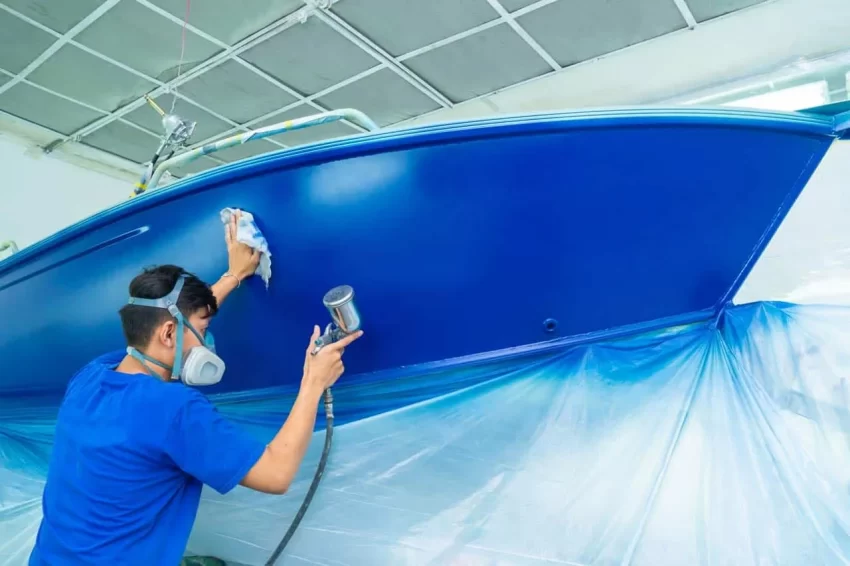How To Select Marine Paint

Hello, seafarers. Are you ready for a high-speed voyage on the seas? The appearance, durability, and performance of your boat are all affected by the choice of marine paint. Marine Paint adds aesthetic appeal to a boat and protects it from the elements like water, sun, and salt. It can reduce drag and increase fuel efficiency.
Consider the following factors when choosing marine paint: the type, the conditions of the water in which the boat is to be used, as well as the application method and expected maintenance. These factors can influence the durability and efficiency of the paint as well as its overall appearance. Don’t make the mistake of a sailor that forgot to batten the hatches. Take the time to choose the right paint for your boat. You’ll be rewarded with a boat that will last a lifetime and a reputation for being savvy.
Key Takeaways
- The right marine paint will enhance the appearance of your boat and protect it.
- Marine paints come in different varieties, including antifouling, topside, and bottom paints. Each has its own application and purpose.
- Consider factors like water conditions, hull materials, and the application method when selecting marine paint.
- The correct application of marine paint will ensure a long-lasting paint and a smooth finish.
- Regular cleaning and touch ups of your boat’s paint can help maintain its value and make it look great.
Types of marine paints
Marine paints are available in a variety of types, all with a different purpose. Here are the most popular types of boat paints.
Antifouling Paint – Antifouling Paint The antifouling painting protects the boat’s hull from marine organisms such as barnacles and algae. Biocides are used to inhibit the growth and attachment of marine organisms. It is recommended to use antifouling paint in environments with saltwater or brackish waters.
Topside Paint – Topside Paint The topside paint protects the upper portion of the boat, above the waterline. It can be applied to the deck, cabin and other exposed areas. Topside color is available in matte, glossy and other finishes. It can be customized according to the desired appearance of the boat.
Bottom Paint – Bottom Paint protects the boat’s hull below the waterline. It stops the growth of marine organisms such as mussels and barnacles that can reduce boat performance. It is recommended to use bottom paint in freshwater or saltwater environments.
Epoxy Paint – epoxy paint is a two part paint system which is resistant to chemicals, water and abrasion. It is used to protect hulls from corrosion and moisture. The epoxy paint can be used to give a glossy, protective finish and added protection.
Varnish – Varnish enhances the natural beauty of the wood on your boat. It gives the wood UV protection, moisture resistance and durability, allowing it to last longer and keep its beauty.
Marine paints are chosen based on their intended purpose and the environment in which they will be used. for example, is used in saltwater environments to prevent marine growth. can be used on the topside of the boat to protect it against UV rays and enhance its appearance. Bottom paint is best for boats that are in the water a lot, and varnish for wooden surfaces with a need for protection.
Considerations when choosing marine paint
There are many factors to consider when choosing the right marine paint. Here are the top factors to take into consideration:
Water conditions -The type of water that the boat will use is an important factor to consider before choosing boat paint. Each type of water has different environmental conditions which can impact the performance and durability. For example, saltwater can be corrosive, and requires paint that is more durable to withstand harsh environments.
Hull material -The material of your boat’s hull should also be considered when choosing boat paint. Paints are made to stick to different materials such as wood, fiberglass or aluminum. To ensure maximum protection and adhesion, it’s essential to select a paint compatible with your hull.
Application method – The method used to apply the paint will also influence the final look and performance. Paints such as epoxy require a certain application method. Other paints, like topside paint, are applied with a roller or brush. For the best results, it’s important to select a paint which can be applied with the desired application method.
Expected maintenance – When choosing boat paint, you should also consider the expected maintenance. For some types of paints such as Antifouling Paint they require more frequent maintenance such as cleaning or touch-ups to maintain their efficacy. Choose a paint that suits your maintenance schedule and skill.
Tips on evaluating the factors and making a decision
You can consult a boat maintenance professional, like All Marine Services to evaluate different factors and select the best boat paint for you. Offers free technical assistance.
Compare the performance, durability and cost-effectiveness of different marine paint brands and types.
Consult the application instructions and recommendations of the manufacturer to confirm compatibility with the hull material on your boat and the intended application method.
Consider the expected lifetime of the paint as well as the frequency of maintenance needed to ensure that the paint remains effective.
Remember that choosing the right marine paint will improve the performance and look of your boat for years to come. So make sure you do some research before making a decision.
Marine paint application
It is important to apply marine paint correctly in order to achieve a durable, smooth finish. This will protect your boat against the harsh marine environment. Here’s how and why to apply marine paint:
Proper application will ensure that the paint adheres and forms a barrier to protect against the elements.
Paint applied unevenly or thinly may result in a weak adhesive that could crack, peel or fade too early.
A proper application will also help the paint to dry evenly and keep its color and shine for longer.
How to apply marine paint: Step-by step instructions
Surface Preparation – Before painting, thoroughly clean the surface to remove all dirt, grease or other contaminants. Sand the surface in order to create a rough texture which will promote adhesion.
Primer – Primer is used to create a smooth surface for painting and to improve adhesion. Let the primer dry completely before painting.
Paint can be applied with a roller, brush or spray gun depending on the paint type and desired finish. Avoid overloading your roller or brush by applying the paint thinly and evenly.
Allow each coat to completely dry before applying the subsequent coat. According to the manufacturer, the recommended time for drying between coats will vary.
Sanding- Lightly sand the surface between coats to promote adhesion and create a smooth texture.
Final Coat- Use the same technique to apply the final coat. Let the final coat dry completely before you use the boat.
Tips to achieve a smooth and even finish
To achieve a professional finish, use high-quality tools and paint.
Paint in thin even coats. This will prevent drips and runs.
Paint should not be painted in direct sunlight, or when there is high humidity. This will cause the paint to dry too quickly.
The manufacturer will tell you how many coats to apply and the time between each coat.
Between coats, lightly sand the surface to create a smooth texture. This will promote adhesion.
To ensure that the paint is applied evenly, use a brush or roller of high quality.
Mix the paint well for consistency.
Maintenance of marine paint
It is important to apply marine paint correctly in order to achieve a durable, smooth finish. This will protect your boat against the harsh marine environment. Proper application will ensure that the paint adheres and forms a barrier to protect against the elements. Uneven or thin application of paint can lead to a weak bond which can cause it to peel or crack prematurely. This ensures that the paint dries uniformly and retains its gloss and color for longer.
Where can I buy marine paint?
In conclusion, selecting the right marine paint will protect your vessel against the harsh marine environment while ensuring that it looks great. When choosing the right paint for your vessel, you should consider factors such as water conditions, hull materials, and application methods. After you have chosen the paint that is right for your boat, make sure to use it correctly to get a smooth and even finish. Remember that a properly maintained paint job can not only look great, but also preserve the value your boat.




Leave a Reply